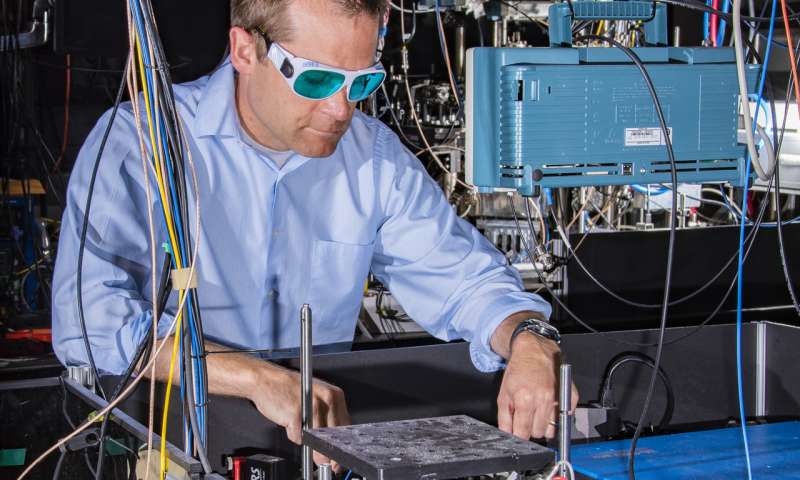This new atomic clock is so exact, it could be used to detect dark matter

Scientists have invented a new clock that keeps time more precisely than any that have come before.
The clock is so accurate that it won't gain or lose more than one second in 14 billion years—roughly the age of the cosmos. Its ticking rate is so stable that it varies by only 0.000000000000000032 percent over the course of a single day.
That level of exactitude is not really necessary for those of us who rely on clocks to get us to a doctor's appointment on time, or to know when to meet up with friends.
But keeping time is just the beginning. This new clock is so exact that it could be used to detect dark matter, measure the gravitational waves that ripple across the universe, and determine the exact shape of Earth's gravitational field with unprecedented precision.
Indeed, these hyper-accurate clocks can help scientists better probe the mysteries of the cosmos, experts said.
"It turns out that if you have all these digits of precision for making a measurement, it can give you a microscope onto our very universe," said physicist Andrew Ludlow of the National Institute of Standards and Technology in Boulder, Colo. Ludlow led the work that produced the new clock, which was described this week in the journal Nature.
Since the 1960s, time has been measured by so-called atomic clocks that use the natural oscillations of a cesium atom as a pendulum. Think of it as a watch with a hand that ticks just over 9 billion times per second.
The optical lattice clock Ludlow and his colleagues developed measures the much faster oscillations of a ytterbium atom. Its atomic pendulum swings about 10,000 times faster, at a speed of 500 trillion times per second.
"Cesium is a beautiful atomic system, but we have reached the basic limits of how good it can be," Ludlow said. "Ytterbium can break down time into much finer intervals, enhancing the precision with which you can measure it."
Optical lattice clocks have been around for only 15 years, and they are still in the development stage, Ludlow said. Scientists continue to tinker with them, gradually increasing their accuracy with each new adjustment.
Most of the improvements in the latest iteration are due to a new heat shield that Ludlow's group developed a few years ago. It protects the ytterbium atoms from the effects of heat and electric fields, which can interfere with their natural oscillations.
"We want to be sure that when we are measuring the ticking rate of the atom, we are measuring the rate Mother Nature gave it, and that it is not perturbed or shifted due to an environmental effect," he said.
With so many oscillations, the ytterbium clock can detect shifts in the gravitational field of our planet with unprecedented precision, Ludlow and his coauthors wrote in Nature.
As Einstein's theory of general relativity predicts, time moves differently depending on where you are in a gravity field.
A clock on top of a tall mountain—far from Earth's center—will tick a tiny bit faster than a clock at the base of that same mountain.
It's not a mechanical error. Time actually passes faster at the top of that mountain.
Most clocks aren't accurate enough to register that extremely subtle difference. After all, in 10 years, two clocks that are 1,000 meters apart in altitude will be off by just 31-millionths of a second.
Scientists have already demonstrated that it is possible to measure differences in Earth's gravitational field by comparing the tick rate of two optical lattice clocks in different locations. However, until now those same gravity maps could be made just as accurately using other, cheaper techniques.
The new clock can detect changes in just 1 centimeter of elevation, a measurement far more precise than was previously possible, Ludlow said.
In addition, his team is part of an international collaboration that is using hypersensitive clocks to try to detect dark matter, the mysterious stuff that is thought to be five times more plentiful in the universe than normal matter.
"Very little is known about dark matter, but most theories predict that it would interact with atoms in a way that would impact the ticking rate of our clock," he said.
The team is also experimenting with using the clocks to look for the same types of gravitational waves that were first observed with the LIGO observatory, confirming an important aspect of Einstein's signature theory.
Despite the incredible precision of the new clock, the team has not yet reached the limit of its capabilities. More tinkering is already in the works.
"The performance is like nothing we have ever seen before," Ludlow said, "but we already have some ideas on how we want to rebuild things that could lead to even more significant improvements."
More information: W. F. McGrew et al. Atomic clock performance enabling geodesy below the centimetre level, Nature (2018). DOI: 10.1038/s41586-018-0738-2
©2018 Los Angeles Times
Distributed by Tribune Content Agency, LLC.


















